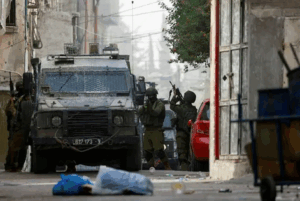If you want to know what Gaza’s future will be, just look at the West Bank

An Israeli soldier aims his weapon during a raid at the Balata refugee camp east of Nablus city, August 2025
Jack Khoury writes in Haaretz on 3 September 2025:
“The day after” has become a cliche in talking about Gaza, in Israel and abroad. Everyone asks what will happen when the fighting stops, who will govern and what will be in the Strip. From Israel’s perspective, the answer has been around for decades.
It proves itself and, most importantly, it preserves Israel’s interests: It’s the West Bank model. Israel has full control in Area C, about 60 percent of the territory. There it nurtures the settlement enterprise and maintains strict military control and de facto apartheid: nearly unlimited freedom of movement for settlers, severe restrictions for Palestinians.
In Gaza, it seems, Israel would settle for about 25 percent of the territory – buffer zones, security boundaries, strategic corridors – while retaining freedom to act anywhere, anytime.
In the West Bank, anything that enters or exits – water, fuel, food, medicine – is under total Israeli supervision. It’s a “breathing siege”: controlled suffocation that avoids complete collapse. This principle has been in effect for years in Gaza. It’s how a population of millions could be managed without having human or national rights.
In the West Bank, any home, any village can become a military target in an instant. No area is immune to arrests, targeted killings or night raids. It is a mechanism that creates a permanent sense of insecurity and prevents significant organization for political or security purposes. By this logic, Gaza will be no different. There, too, the Israeli military would retain complete freedom of action, able to enter, raid and attack at will.
An Israeli work permit is needed to enter Israel from the West Bank for employment in Israel. This control allows Israel to hold the Palestinian economy hostage indefinitely: Petah Tikva or Tel Aviv become the daily dream of hundreds of thousands of laborers who are dependent on the whims of the system.
It will be the same for the Gaza Strip: tens of thousands of laborers who will be allowed to enter Israel “on condition of quiet.” That is the essence of the carrot-and-stick approach that has proved itself in the West Bank.
At the same time, there’s internal governance in the West Bank – the Palestinian Authority, which provides services to civilians and cooperates with Israeli security entities. In practice, it’s a government that lacks sovereignty and allows Israel to assert control without taking responsibility for the Palestinian population.
That’s the aim in Gaza too: establishing a weak entity that would be dependent upon Israel both economically and on matters involving security. It would function as a subcontractor to govern the population, alongside an Israeli civil administration and military government and an efficient system of tax collection and offsets that would generate large sums for Israel and fund an inexpensive occupation.
Of course, officials in the Palestinian Authority would be shocked by the comparison, which undermines the myth of a future Palestinian state “in the making” and casts the Palestinian Authority in a less-than-flattering light.
Many Arab countries would not want to be perceived as funding another occupation. But this is Israel’s strategy: creating facts on the ground, presenting the world with a situation in which it’s being asked to assist the Palestinians. A naive world would then underwrite the plan to preserve the two-state solution. It’s been doing so for the past 30 years.
So the plan for “the day after” already exists. It’s not an abstract plan. It’s a model that has been in operation in the West Bank for decades, involving full military control, a system that provides an intermediary with the civilian population and complete economic dependence upon Israel.
Only two components are missing: a Palestinian contractor who would agree to handle the day-to-day administration of Gaza, and Arab or international funding. In the meantime, Israel is gaining control of the Strip and laying the groundwork
This article is reproduced in its entirety
